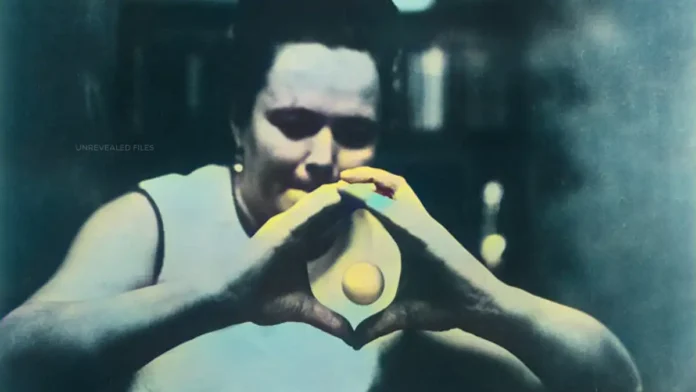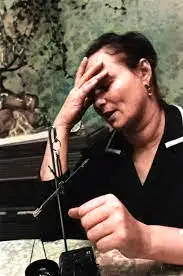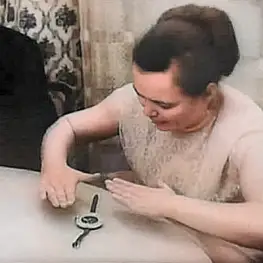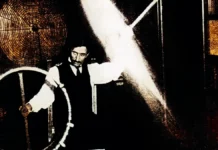
During the Cold War when there was an arms race going on between the US and the Soviets, a woman came out with psychic abilities, who claimed that she could move objects with her mind and psychic powers. Seeing her ability to move objects by psychokinesis, Soviet and Western parapsychologists and the CIA became interested in her and started experimenting with psychokinesis for psychic warfare. Meet the enigmatic figure shrouded in mystery and intrigue—Nina Kulagina. Born in Soviet Russia in 1926, Kulagina gained international attention for her purported telekinetic and psychokinesis powers and extraordinary abilities. In this article, learn about the life and experiences of Nina Kulagina and her fascinating world of psychic phenomena that forced the US and the Soviets to experiment the Psychic warfare.
Contents
Life of Nina Kulagina
Born on July 30, 1926, Nina Kulagina’s journey into the extraordinary began in Leningrad now St. Petersburg, where she spent her childhood years. Her full legal name was Ninel Sergeyevna Mikhailova, “Ninel,” which means “Lenin” spelled backward, was a common name for girls in Leningrad. She was raised in a time of political upheaval and social change, Kulagina’s early life provides a backdrop to developing her psychic abilities, while she was mistakenly identified as Nina Kulagina in the Western media and Nelya Mikhailova in the Russian media.
Along with her father, brother, and sister, Kulagina participated in the Red Army’s defense of Leningrad during the Nazi siege. At the age of fourteen, she joined a tank unit as a radio operator. when she was seventeen, she injured herself in the abdomen while working.
Discovery of her Psychic Abilities
Kulagina’s discovery of her psychic talents was not a sudden revelation but a gradual awakening. In the early 1960s, Kulagina was admitted to the hospital due to a nervous breakdown, which may have been brought on by delayed post-traumatic stress disorder or persistent discomfort from her wound. In early December 1963, a woman on the radio claimed that she could see colors with her fingers, and after hearing her Kulagina also claimed that she could see the colors with her fingers. She recalled how, while recovering in the hospital, she had been able to select the colored threads she needed for her embroidery from an opaque bag without looking at them.
To make her husband believe, she repeatedly tested this talent while wearing a blindfold. In addition, she also proved that she could properly recognize hidden colors, read text, recognize dates on coins, and replicate basic drawings in a different room. When she and her husband disclosed her unbelievable abilities to a physician, her abilities came to light. Soon her abilities attracted many Soviet scientists and military officers and from here the Soviet scientists and five Western scientists who saw Kulagina in a 1968 documentary film conducted more than one hundred sessions of experiments and investigations on her psychokinesis abilities for two decades. Some observations were conducted at Ukhtomskii Military Institute in Leningrad, Russia. On 10 March 1970, she stopped a frog’s beating heart using only her mind.
Electrodes were attached to the frog’s heart with a small ticker, scientists were measuring beats per minute while the freshly removed frog’s heart rested in a solution that might sustain its beating for up to an hour. Kulagina’s pulse rate spiked during the seven minutes it took her to halt the frog’s heart mentally, according to the Soviet medics who kept an eye on her said, “She needed twenty minutes to be ready for the experiment”.
How Kulagina Performed Psychokinesis
Kulagina was able to move little objects in front of her without touching or coming into direct contact with them while seated at a tiny table. Scientists were able to observe her intense mental attention towards the object she tried to move, and her mental abilities always seemed to be the cause of the object’s movement.
The objects she used to move include a wristwatch, an empty metal salt shaker, a cigarette, matchsticks, and an empty matchbox. She would typically start her distance from the things at around half a meter, although reports indicated that she could reach as far as two meters. She even had success using objects that were on the floor or the chairs.
The objects would move away from her after first moving in her direction. Kulagina would initially move her head or torso, but later also used her hands as she felt this would aid the process. There were fluctuations in activity at different times, ranging from smooth to jerky. At times, extended operations required several brief moves. Due to their slow speed and lack of maneuverability, operations required constant maintenance of force. Sometimes, Kulagina was able to continue for some time even after her attention was diverted. Like a cigarette, it was easier for her to shake a cigarette that stood on end and which did not fall.
The objects varied in size from a matchbox to a plexiglass cube measuring ten centimeters. Russian scientist GA Sergeyev claimed that Kulagina could weigh up to 500 grams. She could manipulate multiple objects simultaneously in the same direction or two different directions, or she could move a single object along a predetermined path.
Observations included her ability to Spin a compass needle 360 degrees in either direction, Halt a pendulum or alter its swing direction, Move a hydrometer floating in water within a wire cage, and Prevent a scale from unbalancing when extra weight was added to one pan.
In image 1, you can see that Kulagina seemingly levitating a little ball between her palms, this image of Nina Kulagina was taken by Vladimir Bogatyrev while Kulagina was using her hands to emit or shape telekinetic force to raise a Ping pong ball off the table. In 1968, the AP wire service reported on Kulagina (identified as Nelya Mikhailovo) worldwide. Sergeyev, who accompanied Kulagin during the experiment, believed that she had revived a nearly dead fish, with one fish swimming upside down and the other lying motionless on the aquarium floor. Due to which it remained floating for several minutes, Kulagin also stopped the heartbeat of a disembodied frog.
Whenever Kulagina lightly touched someone’s skin, it was reported that the strength of the heat varied from person to person. Some reported excruciating pain, while others experienced heat and pain that were bearable and left burns, but no blisters. There was no difference in temperature between the observer’s hand and the thermometer placed between them. Sergeyev claimed that she could create psychologically basic designs on light-sensitive paper, but Western experts were unable to find any concrete evidence of this.
Psychic Arms Race Between the US and the Soviets
When she was said to raise the heart rate of a doctor there, who wasn’t convinced about her abilities. They were both connected to electrocardiogram (EKG) devices. The experiment was stopped after a few minutes when analysts noticed that the doctor’s heart rate was increasing at a dangerous level. Videos of these experiments leaked to the US Defence Department, but the views in the US varied, some said the Soviets intentionally made it to frighten them, but the frog experiment grabbed their attention. Soon these psychokinesis abilities started the Psychic Arms race between the Soviets and the US. Both nations started experimenting with human psychic abilities for espionage, stealing confidential information with psychic remote viewing or remotely viewing high-ranked officials.
Because both the US and the Soviets were dedicated to gathering information from one another, they started spy programs with highly skilled at hiding their identities. They obtain secrets without disclosing who they are by using wiretaps, double agents, and other conventional techniques, but all of these techniques are dangerous. They thought it would be even more advantageous if we could know not only the enemy’s plans but also his thoughts to change them or carry out remote destruction without the need for costly armaments. The potential for psychological warfare appeared limitless, despite cautious enthusiasm about these talents.
During the Cold War Soviets had banned anything related to the paranormal or mysticism, but they later changed their minds after realizing they could use mysticism or Psychokinesis to spy on their enemies, They had also framed their actions in more scientific terms so they could convince their citizens.
According to Jacobsen, in 1963, they changed the way they talked about ESP to make it sound more technical and less connected to the occult. Some of the big changes included calling Mental Telepathy “long-distance biological systems transmissions.” Moving things with your mind became known as psychokinesis, or “non-ionizing, in particular electromagnetic, emissions from humans.”
Note: ESP stands for “extrasensory perception.” It refers to the ability to perceive information beyond the ordinary human senses. This can include abilities such as telepathy (mind-to-mind communication), clairvoyance (perceiving distant or hidden events), and precognition (predicting future events). ESP is often associated with paranormal or psychic phenomena, and its existence is a topic of debate and skepticism within the scientific community.
In the 1960s the Soviets also focused a lot on studying energy to gain a better understanding of the energetic fluxes that surround humans. They wanted to use that energy to influence physical systems.
In 1962, American military engineers conducted a normal security scan of the U.S. Embassy in Moscow and found unusual electromagnetic signals coming from an apartment building across the street, which was located on the tenth floor. They discovered that the signal had been in operation for more than six years and was directed towards the higher levels of the Embassy building. At that point, the Pentagon started its initiative. They tasked the Advanced Research Projects Agency with starting a classified programme to “duplicate the effects of the Moscow signal,”.
Thus, comparable research was conducted domestically. Eight years later, the United States launched a joint intelligence assessment to investigate what they were calling the “Soviet psychoenergetic threat” in response to the Kulagina tapes and her psychic abilities. After two years of investigation, the final report was published. It concluded that the Soviets were working on “methods of controlling or manipulating human behavior through subtle, non-identifiable means” and that they had a keen interest in “parapsychology,” the word used in the United States to refer to the study of extrasensory perception.
As the US became aware of what the Soviets were doing, in 1978 CIA launched the StarGate program. It was a psychic initiative focused on developing the ability to remote view or see distant locations with psychic abilities. In experiments, people who claimed to have psychic abilities were asked to describe what they saw after being told the longitudinal and latitudinal coordinates of a Soviet military base.
The descriptions they provided were many times accurate. The CIA used the phrase “anomalous cognition” to characterize the novel information-gathering techniques it was pursuing, much like the Soviets, who developed an entire technical lexicon around their investigations into extrasensory perception.
Although there were always many who opposed the psychic programs, they continued into the 1990s and maybe even beyond. According to a 1984 Washington Post article, “Former CIA director Stansfield Turner told critics their skepticism about the CIA’s psychic projects was healthy, but that research should keep pace with their skepticism.” The article detailed the CIA’s sustained commitment to psychic research.
On the other hand, skeptics and magicians believed Kulagina had staged her purportedly telepathic exploits. The Russian newspaper Pravda exposed her as a scammer. In 1987, she filed a defamation lawsuit and won in part. Her exposure, however, had no impact on the Soviet or even post-Soviet race for a psychic edge. Program participants say that as late as the Chechen wars, Russia employed units of military psychics.
There is very little information available about how much the US and the Soviets succeeded in these psychic warfare techniques and experiments.
Scientific Scrutiny and Controversy
Scientific Scrutiny of Nina Kulagina
Keil and his co-authors believe that Kulagina was able to elicit Psychokinesis effects in about 80% of her attempts on average. She was hindered by the hostile onlookers, but if she persevered, she would eventually succeed. Different materials used for the screens have no inhibitory impact. Her notable inability to move a thing in a hoover may have resulted from the object being hidden in a hermetically sealed container, which seemed to have an inhibiting impact, rather than the hoover itself. Kulagina claimed that it was challenging to attain Psychokinesis in stormy and hot weather, and high humidity was also found to be an inhibitor by Russian Scientist Sergeyev.
During her psychokinesis attempts, Kulagina’s heart rate was discovered to spike, reaching as high as 240 beats per minute. Ullman recorded a heart rate of 132 while working and 85 when at rest. During sessions, Kulagina frequently lost up to two kilograms of weight—more than she would usually lose in a comparable amount of time through intense physical activity. She reported experiencing severe fatigue, lightheadedness, and discomfort in her neck, upper back, legs, and feet, as well as general pains and a metallic aftertaste. She occasionally needed one or more days off in between sessions. During Psychokinesis effects, EEG monitoring revealed noticeable alterations, including an energy concentration in Kulagina’s direction of gaze.
Kulagina frequently had her husband and other people film her psychokinesis effects. You can find a lot of videos, including this one, on YouTube that demonstrate hand gestures, compass testing, and the addition of subjective heat sensations. This movie also includes her last test, in which she failed to do psychokinesis, and experiments using what appears to be real heat to cut wires and brand plastic.
A brief interview with Keil and footage from when he and Pratt unannouncedly stopped by Kulagina, who extended an invitation to stay for supper and a psychokinesis demonstration, is featured in the video below.
Watch another Video of Nina Performing Psychokinesis: Nina Moving Matchbox
Psychiatrist Jan Ehrenwald proposes in his paper on a neuropsychiatric model of psi that psi challenges the conventional distinction between ego and non-ego, blurring the line between what one identifies as I versus not I. He draws a parallel between psi and physical paralysis, where something that was once a part of the self becomes, in essence, separate. Ehrenwald notes the comparable effort exerted by psychics like Kulagina to move small objects and the effort a patient needs to mobilize a paralyzed limb.
Liudmila Boldyreva contends that Kulagina’s inability to move objects in a vacuum contradicts the theory suggesting that her particle beam technique or Psychokinesis relies on particle emission, a process unaffected by a vacuum. Boldyreva interprets various observed traits as indications that the psychic’s mental influence, described as a push, impacts fermion spins—pairs of oppositely charged particles—while passing through a disturbed superfluid.
Parapsychologist Stephen Braude suggests that documented cases of macro-psychokinesis in the 20th century, including Kulagina’s, appear to involve more effort and discomfort compared to earlier individuals like DD Home. Braude speculates that this change could be attributed to an increasing public unease about psi and its potential implications. In a somewhat thoughtless manner reflecting self-deception, Braude remarks, “If a psychic has to exert such effort to achieve minimal results, it might be perceived that no human psychokinesis effort (or only a fatal one) could produce a phenomenon worth concern.” From the beginning of the scientific investigations, Kulagina was accused of fraud many times, However, none have ever been proven.
Controversies
Some people and groups, like the James Randi Educational Foundation and the Italian Committee for the Investigation of Claims on the Paranormal (CICAP), doubt claims about psychokinesis. Massimo Polidoro believes that the experiments with Kulagina had long preparation times and uncontrolled settings, like hotel rooms, which made it easy for tricks to happen. Magicians and skeptics think Kulagina’s abilities could be done by someone skilled in sleight of hand, using things like hidden threads, small pieces of magnetic metal, or mirrors. They also suggest that during the Cold War, the Soviet Union might have had reasons to fake or exaggerate results for propaganda purposes, similar to the Space Race or arms race.
Back in the 1960s, a Russian journalist named Vladimir Lvov wrote an article in Pravda accusing Kulagina of being a fraud. Lvov claimed that she used a trick in which she hid a magnet on her body to perform one of her feats. The article also mentioned that Kulagina had been arrested for deceiving the public and taking five thousand rubles from them. Science writer Martin Gardner described Kulagina as a “pretty, plump, dark-eyed little charlatan” who was caught using tricks to move objects. According to Gardner, Soviet scientists caught her cheating on multiple occasions.
In 1986, the Soviet Ministry of Justice’s magazine, Man and Law, accused Kulagina of fraud. Kulagina responded by suing the magazine’s journalists for defamation, and about a year later, she achieved a partial victory in the lawsuit. The court decided that the journalists lacked direct evidence of fraud. Notably, Kulagina was not present at the trial. The Russian Skeptic Society has pointed out that the trial’s outcome doesn’t provide confirmation or denial of Kulagina possessing anomalous abilities.
Conclusion
Nina Kulagina’s extraordinary abilities captured international attention, turning her life into a captivating public spectacle. Despite the controversies and widespread skepticism, she managed to leave an indelible mark on the world of psychic phenomena. From the inception of her scientific investigations, Kulagina faced persistent accusations of fraud, yet none were ever proven, but one thing is sure, her abilities forced the US and the Soviets to conduct psychic warfare experiments during the Cold War, adding a layer of intrigue to her already mysterious story.
Despite the international intrigue surrounding her, Kulagina’s life took a poignant turn. After battling a prolonged illness, she passed away on April 11, 1990, at the age of 63, succumbing to a heart attack. Her legacy continues to be shrouded in mystery, with believers and skeptics alike engaging in ongoing debates about the authenticity of her extraordinary abilities. As we delve into the complexities of Kulagina’s life, it becomes clear that her story transcends the boundaries of mere skepticism and controversy – it’s a narrative that resonates with the intrigue of a Cold War-era psychic warfare.
If you found Nina Kulagina’s story fascinating then also read the story of Candy Jones.
Sources
- Conrad, James A. 2016. The Ninel Kulagina Telekinesis Case: Rebuttals to Skeptical Arguments.
- Randall, John L. (1975). Parapsychology and the Nature of Life. Souvenir Press. p. 185.
- Kolodny, Lev. “Moskovskaya Pravda (Moscow Pravda)”, 17 Mar. 1968.
- “K – Encyclopedia of Claims.” JREF, web.randi.org/k—encyclopedia-of-claims.html.
- Boldyreva, Liudmila B. “IS LONG-DISTANCE PSYCHOKINESIS POSSIBLE IN OUTER SPACE?.” The Parapsychological Association, Inc. 50th Annual Convention Proceedings of Presented Papers. 2007.
- Herbert, Benson. “Report on Nina Kulagina.” Parapsychology Review (1972).
- Cassirer, Manfred. “Experiments with Nina Kulagina.” Journal of the Society for Psychical Research (1974).
- Dulnov, G. N. “Scientists study phenomena of Nina Kulagina.” Psi Research (1984).
- Ebon, Martin. Psychic Warfare: Threat Or Illusion? McGraw-Hill, 1983.
- Polidoro, Massimo. “Secrets of a Russian Psychic.” Skeptical Inquirer (1997): 45.
- Jones, CB Scott. “Essay Review of” Psychic Warfare: Fact or Fiction?” The Journal of Parapsychology 53.2 (1989): 141.
- McKelvy, Dolan M., and AIR WAR COLL MAXWELL AFB AL. Psychic warfare: Exploring the mind frontier. Air War College, Air University, 1988.
- Superstition : Planer, Felix E : Free download, borrow, and streaming : Internet Archive. (1988). Internet Archive.
FACT CHECK: We strive for accuracy and fairness. But if you see something that doesn’t look right, please Contact us.
DISCLOSURE: This Article may contain affiliate links and Sponsored ads, to know more please read our Privacy Policy.
Stay Updated: Follow our WhatsApp Channel and Telegram Channel.














